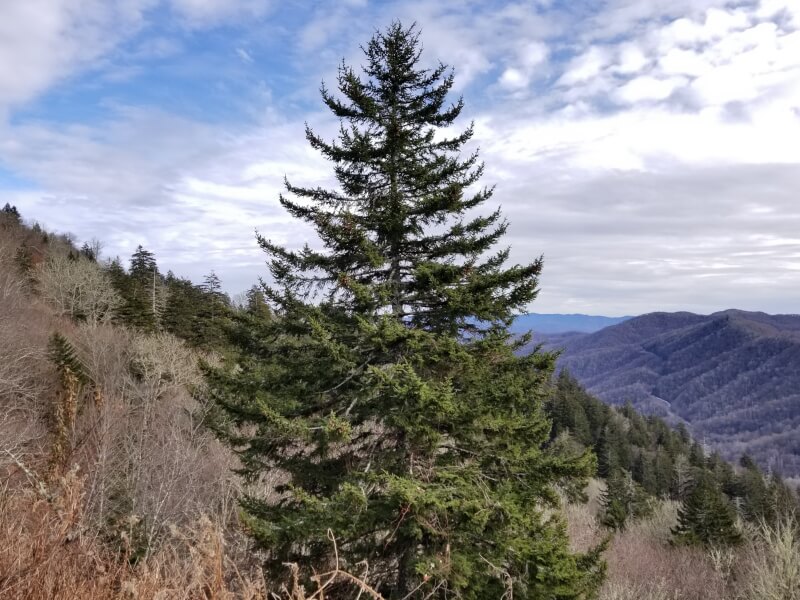Growing from New England and the Maritime Provences of Canada south to the Blue Ridge Mountains in Tennessee and North Carolina, red spruce (Picea rubens) is a very stately native evergreen.
Red spruce features deep green needles set thickly on rusty red twigs. Its range overlaps with white spruce (Picea glauca) and black spruce (P. mariana), both of which Red spruce is superficially similar to. They are reasonably easy to tell apart – white spruce has much lighter and longer needles, and black spruce has shorter needles with a bluish tint. Red spruce is also the only spruce that ranges into the central and southern Appalachians.
Old growth red spruce can become huge, with 4-plus foot diameter trunks and 150-foot tall crowns. These sizes are more typical in the southern Appalachian mountains. As the trees age, the bark takes on a uniform, platy appearance. Lower limbs often drop off in closed-canopy situations, leaving a tall, straight trunk with deep green foliage concentrated in the top third of the tree.
Estimated to have covered as much as 10 times the area in the Appalachians as it does today, red spruce was extensively logged in the 1800s and 1900s. Today, it has become a sort of poster child for conservation efforts, and thousands of acres of spruce seedlings are planted every year from Maryland and West Virginia into the Southern Appalachians. These efforts have been successful, and in 50 to 100 years, extensive spruce forests may once again crown the Appalachian Mountains.
For a spruce, red spruce is very shade tolerant, as much so as Eastern Hemlock and White Cedar – This feature enables it to establish in the cover of hardwoods, slowly growing as an understory tree until a disturbance in the canopy allows it to take over. Capable of living 300 to 400 years, red spruce is the longest-lived of the eastern spruces.
In the landscape, red spruce is often as wide as it is tall, unless planted closely together – In the wild, red spruce can be found both as single, spread-out trees in open glades as well as in dense, closed-canopy forests where little light is able to reach the forest floor. Both settings are beautiful in their own right.
Uses
Red spruce is a highly valuable tree – It is one of the most important lumber trees in the Northeast, being mixed with white and black spruce as “eastern spruce”. With its light density, clear straight grain, and resonant qualities, Red Spruce is highly preferred for making musical instruments. Red spruce is also used by the paper pulp industry.
Red spruce is an important wildlife species – Many animals rely on spruce groves for winter shelter, and hares and grouse browse the buds and young growth. Red Spruce seeds are eaten by Red-Breasted Nuthatches, Crossbills, Pine Siskins, and other seed-eating birds. Red spruce is reported to be unpalatable to white-tailed deer – An excellent evergreen tree in areas with high deer populations!
Red spruce, when growing in a closed canopy stand, creates its own microclimate – red spruce forests are characterized by low evaporation rates, damp peaty soils, and a ground cover of incredibly lush moss. Peat soils are mostly comprised of partially decomposed organic matter, which stores carbon in a stable state deep in the soil. These features make Red Spruce well-suited to offset carbon emissions, and initiatives are under way to restore the vast spruce forests that once existed from Maryland to Tennessee and North Carolina as a means of sequestering carbon.
How to Grow Red Spruce
Red spruce is said to be slow-growing and difficult to cultivate; we have grown it easily enough here in Central Indiana. The key to success is a site with rich soil that never dries severely and a little afternoon shade. Red spruce grows best in areas with cool summer temperatures and high rainfall.
Widely adaptable to different soil types, red spruce is typically found on gravely soils and muck soils. However, it achieves its best form on the well-drained, organic soils of the Southern Appalachians. In the garden or landscape, Red Spruce grows best in moist, well-drained soils, although it will tolerate slightly boggy or clay soils. Red spruce grows very well in “shelterwood” stands, where canopy trees have been thinned to allow more light into the ground layer while still providing enough cover to limit moisture loss through evaporation and block drying winds.
Red Spruce is an excellent medium-sized evergreen for windbreaks, grouping, naturalizing, and specimen planting. Though uncommon in the landscape, Red Spruce makes a beautiful specimen, with full, dense growth and an excellent tiered structure. Space 8-15 feet apart for naturalizing and windbreaks; To allow full natural growth, space at least 15 to 30 feet apart.
Red Spruce is best planted in early Autumn, preferably with at least 8 weeks of frost-free weather for establishment. Spring is the second-best time; However, in the North, soils can be frigid late into the spring, hampering root development.
Red Spruce can be a bit slow-growing at first; However, it is capable of growing 1 foot or more a year in good conditions.
At-a-Glance Information
| Common Name: | Red Spruce |
| Botanical Name: | Picea rubens |
| USDA Hardiness Zones: | 2-5 |
| Height: | 100+ feet |
| Spread: | 20-30 feet |
| Spacing: | 12 feet |
| Flower Color: | n/a |
| Bloom Time: | Late Fall |
| Texture: | Fine |
| Habit: | Cone-Shaped Conifer |
| Light Exposure: | Shade to Full Sun, does best with afternoon shade in warm climates |
| Soil Moisture: | Moist |
| Soil Texture: | Clay Loam to Sandy Loam |
| Soil PH: | Slightly to Strongly Acidic |
| Landscape Uses: | Evergreen Canopy Tree, Accent Tree, Windbreak, Screen |
| Benefits: | Attracts songbirds, furthers conservation efforts |
| Ecological Function: | Soil Stabilization, Browse, Shelter |


Leave a Reply